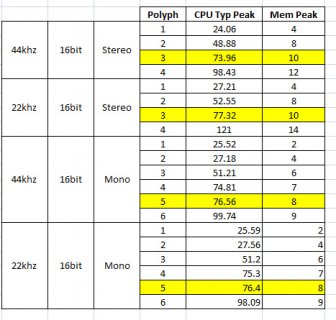Pensive
Well-known member
I've done a WAV file streaming test, using a hobbytronics standard Transcend 4gb MicroSDHC. No speed rating on the packaging at all im afraid.
Summary
44Khz stereo = 3 voices
44khz mono = 5 voices
22khz stereo = 3 voices
22khz mono = 5 voices

note:
peak cpu readings were estimated based on 4 second updates detailing the current CPU usage and peak since last update.
Sometimes this would fluctuate very high, and i would ignore the higher ones which is bad form but at least it gives a feel for the capability.
I've left a 25% headroom for the rest of people code when detailing the maximums, so where we hit around 75% peak is where i capped it.
There were a lot more spare cpu cycles in mono mode, which werent represented by peak readings, however it would appear that 22khz mode doesn't actually save any cpu cycles really, even though all it has to do is double up the sample and do a 32bit transfer, I assume adding the two samples together for transmit is no quicker than pulling the stream over SPI once its rocking along.
Interesting, and 5 voices is not too shabby in mono for 16bit 44khz.
I'd like to do a u-law test next but I don't think the WAV reader supports u-law files at the moment.
Summary
44Khz stereo = 3 voices
44khz mono = 5 voices
22khz stereo = 3 voices
22khz mono = 5 voices

note:
peak cpu readings were estimated based on 4 second updates detailing the current CPU usage and peak since last update.
Sometimes this would fluctuate very high, and i would ignore the higher ones which is bad form but at least it gives a feel for the capability.
I've left a 25% headroom for the rest of people code when detailing the maximums, so where we hit around 75% peak is where i capped it.
There were a lot more spare cpu cycles in mono mode, which werent represented by peak readings, however it would appear that 22khz mode doesn't actually save any cpu cycles really, even though all it has to do is double up the sample and do a 32bit transfer, I assume adding the two samples together for transmit is no quicker than pulling the stream over SPI once its rocking along.
Interesting, and 5 voices is not too shabby in mono for 16bit 44khz.
I'd like to do a u-law test next but I don't think the WAV reader supports u-law files at the moment.

